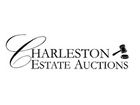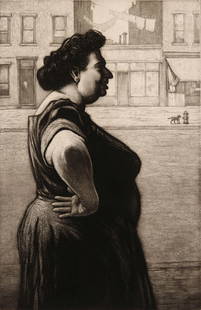
JOHNNY FRIEDLAENDER (1912-1992) AQUATINT ETCHING
Johnny Friedlaender Sale History
View Price Results for Johnny FriedlaenderRecommended Items











Item Details
Description
Johnny Friedlaender (1912-1992) "Le Soir", an original etching and aquatint on arches wove paper, signed in pencil by the artist. One of 20 Artist's Proofs. This is a very small edition of only 95 signed copies and 20 artist proofs. This print was the cover art on volume III 1977-1982 of Friedlaender's catalog raisonne. It has been museum mounted with UV glass and archival acid-free mat. Size of the illustration 75x55.5cm, paper 91.5x63cm. In Frame measures 30"x33"x2". Weight is 14 pds 4 oz. With the original COA signed by Michelle Champetier of Michelle Champetier Fbe Art in Cannes, France. PROVENANCE: The Descendants of Marshall M. Fredericks, American Sculptor. Friedlaender was a leading 20th-century artist, whose works have been exhibited in Germany, France, Netherlands, Italy, Japan and the United States. He has been influential upon other notable artists, who were students in his Paris gallery. His preferred medium of aquatint etching is a technically difficult artistic process, of which Friedlaender has been a pioneer. Gotthard Johnny Friedlaender was born in Pless (Pszczyna), Prussian Silesia, as the son of a pharmacist. He was graduated from the Breslau (Wroc?aw) high school in 1922 and then attended the Academy of Arts (Akademie der Bildenden Künste) in Breslau, where he studied under Otto Mueller. He graduated from the Academy as a master student in 1928. Johnny Friedländer studied at the school of fine arts in Breslau (now Wroclaw, Poland) under Otto Müller (a former member of Die Brücke) and Carlo Mense. He moved to Dresden in 1930 and lived there until 1933, apart from short stays in Berlin and Paris. In 1933, Friedländer was interned in the first of the Nazi concentration camps, but was released in 1935. He sought refuge in Czechoslovakia before moving to Holland. He moved to Paris in 1937 and earned a living by contributing to various periodicals. At the outbreak of World War II he was arrested in Paris along with other foreign nationals, but made good his escape and enlisted in the British Army. He was captured again but once more somehow contrived to escape. At the end of the war, he returned to live in Paris where, in 1949, he set up an engraving workshop ( L'Atelier de l'Ermitage), together with another refugee, the engraver Albert Flocon. That same year, he met and made friends with Jacques Villon. In 1959 he opened an engraving workshop annexed to the Modern Art Museum in Rio de Janeiro. In 1966-1967 he taught at the Salzburg summer school and it was during this period that he started painting again for the first time since the 1940s. Friedländer's earliest work dates from 1928 and comprises black-and-white figurative engravings in the Expressionist manner. Over time, however, he worked in etching and aquatint to develop his own pictorial language which, as Bernard Gheerbrandt has pointed out, used 'progressively abstract symbols to conduct a magic dialogue with the cosmos' ( White Birds; Evening Landscape; Frost).His backgrounds are built up from delicate points, dots, tracings and mysterious forms that evoke complex landscapes. His later engravings are equally subtle, with all the point and counterpoint of a musical figure. He was a highly accomplished engraver, able to evoke emotion with a single line or graceful curve. His work stands apart from the purist engravings of a Flocon, the multiple-inking technique of a Hayter or the incised monochrome of a Courtin: Friedländer's work is complex and baroque. As Nesto Jacometti has remarked: 'His engravings reinvent and reinstate an ancient and long-forgotten alchemy.' Friedländer started exhibiting in 1930, notably in group exhibitions in Dresden. He went on to participate in numerous group exhibitions elsewhere, including the 1946 Salon de Mai in Paris, the Museum of Modern Art in Tokyo in 1951, the first engraving Biennale in Ljubliana in 1955 (where he was awarded the Jakopic Prize), the 1957 Tokyo Biennale (Kamakura Prize), the 1958 and 1991 Venice Biennale (as a representative of French engraving), and the 7th International Biennale in Norway in 1984, where he was awarded a gold medal. He had his first solo exhibition in 1949 at La Hune Gallery in Paris; he would continue to exhibit there until his death in 1992. His work found favour with Christian Zervos, who wrote an enthusiastic review for the Cahiers d'Art. Subsequently, he exhibited internationally, notably at the Musée Rath in Geneva (1951); Kunstmuseum in Lucerne (1951); Neuchâtel Museum (1951); Museum of Modern Art in São Paulo (1953, 1959); Museum of Art and History in Geneva (1954); Staatliches Museum in Berlin (1957); Museum of Modern Art in Rio de Janeiro (1959); Museum of Art in Cincinnati (1961); Jerusalem Museum of Art (1965); University of Rochester Memorial Art Gallery (1973); municipal libraries in Strasbourg, Mulhouse and Colmar (1974); Museum of Modern Art in Tel-Aviv (1976); Musée de l'Art Moderne de la Ville de Paris (1978); Dresden (first retrospective, 1980); Finland (six museums, 1983); Musée du Luxembourg (1984); Kunsthalle in Bremen (1987); Chancellery in Bonn (1992); Couvent des Cordeliers and Goethe Institute in Paris (1994); at Homage, an exhibition of painting, sculpture and the graphic arts held at the 14th arrondissement town hall in Paris (1994); and in 2001 at the Musée d'Unterlinden in Colmar as part of the Brigitte Coudrain Bequest. Friedländer was awarded the Cross of Merit of the Federal German Republic in 1969 and made an Officier des Arts et Lettres in France in 1978; he was also elected to membership of the Belgian Académie Royale des Beaux Arts in 1990. In 1974, French television released a film on his life ( Friedländer the Engraver (Le Graveur Friedländer) and he featured in two major radio programmes, Johnny Friedländer: Twilight Reality (made in 1987) and Friedländer: A Century of Memories (1991).
Condition
excellent
Buyer's Premium
- 18% up to $50,000.00
- 10% up to $1,000,000.00
- 5% above $1,000,000.00
JOHNNY FRIEDLAENDER (1912-1992) AQUATINT ETCHING
Estimate $1,100 - $1,500
14 bidders are watching this item.
Shipping & Pickup Options
Item located in Mt. Pleasant, SC, usSee Policy for Shipping
Payment
Accepts seamless payments through LiveAuctioneers

Related Searches
TOP





















































